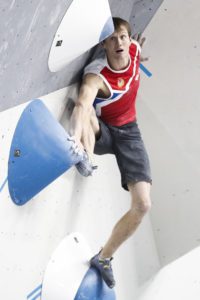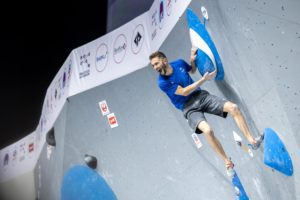Narasaki Dethroned by a New Boulder World Champion
There is a new Boulder World Champion from Japan. Will they dominate in 2022, or did the missing members of the field skew results?

Yesterday afternoon saw the end of bouldering at the 2021 IFSC World Championships. Following an impressive display by the women, the men climbed a rugged semi-final before the afternoon’s event.

Russia’s Aleksey Rubtsov began the round with a powerful attempt on M1. The simple problem appeared almost unbreakable. Gripping the offset side pulls, Rubtsov made movement toward the first of a three-hold sequence. The first two volumes each appeared relatively negative in the wall-angle.
Deadpointing to the first grip, Rubtsov held the swing before hand-foot matching the blocked left-hand start hold. Crossing over and into the second fibreglass feature, the Russian appeared to almost stop his momentum before falling back to the ground. He could not keep his foot on.
Generally, World Cup boulder problems offer a degree of technique that forces the athlete to consider the application of their strength. While all bouldering necessitates a technical component, M1 struck out as a power-based test-piece.
Falling again, Rubtsov pulled on for the third time with new beta. Instead of trying to stop on the second hold, Rubtsov attempted a more dynamic one-two-three-four sequence where he paddled through the first three holds to catch his swing on the fourth. While the third grip did appear positive, its orientation kicked Rubtsov’s hips off the wall. In the end, he could not complete the problem.
Neither Slovenia’s Anze Peharc nor Israel’s Nimrod Marcus would make it any further than the Russian. Instead, it took Japan’s Kokoro Fujii to establish on the second hold.
Forgoing the dynamic paddle sequence, Fujii climbed well within his style. He simply gripped the bad holds. Upon sticking the first move, Fujii campussed to the second hold. He held the rotation and climbed on to flash M1.
As the remainder of the field failed to make Zone, Fujii’s lead became more pronounced. Defending World Champion Tomoa Narasaki simply did not have enough power for the problem. In falling, Narasaki cemented Fujii’s win.
M2 began with a quick ascent by Rubtsov who appeared both frustrated with the difficulty of the problem and the fact that he didn’t flash. The positive grips of the climb made for a near-clean-sweep of the boulder by the competitors. Narasaki, would not flash.
Although Narasaki has retained consistency into this year, he seems to have lost that same self-confidence. He moves well and remains one of the strongest boulderers on the World Cup Circuit. His general proficiency appears to have faltered in these last competitions.

Narasaki podiumed in both Innsbruck and Salt Lake City this year. Still he, failed to win or to climb to his potential at the Olympics. That said, winning a World-level competition has difficulties for even the most consistent male competitors.
The strong field makes it difficult to earn top titles and Fujii’s performance does not lessen Narasaki’s. Instead, it shows that Fujii operates on another level in a certain style. When Fujii reads the beta, he does not fall. Although Narasaki appears more consistent with a greater variety of boulder problems, Fujii’s strength and experience in the sport make him a challenging competitor to best.
As the round progressed, Fujii flashed almost everything. The dynamic M2 proved easy for Fujii as did M3. Fujii did fall on M4, but only once. He climbed the boulder problem on his second attempt.
Over the course of the competition, Fujii did not appear like he had to try hard. Although he and Narasaki shared attempts to Top and were only separated by a boulder, Narasaki struggled to climb the slab. Fujii appeared lighter than air.
Despite his large stature, the Japanese climber moved easily through the round. Over this last season, Fujii made finals at every World Cup. He podiumed twice before the Championships, but could not secure first. His first-place result in Moscow comes as the result of this season’s effort.

France’s Manuel Cornu also had a nice competition, ultimately earning bronze with five fewer attempts than Rubtsov. While Cornu did climb well over the length of this competition, his level of ability did not compare to the Japanese athletes.
In this final round, few were genuinely competitive against the leaders. Without Sean Bailey, Nathaniel Coleman and Adam Ondra competing in Moscow, their results were all but assured. So what comes next?
With the Seoul Boulder World Cup cancelled on account of COVID, the men’s bouldering season concluded ambiguously. Although Fujii did win the World Championships, Ondra and Narasaki’s Olympic-influenced season have made it difficult to know where the top of the field lies.
It may be possible that Fujii is the strongest boulderer in the world right now, but no clear leader exists in the men’s field. Instead, this World Championships marks the end of the international season and gives athletes several months to recollect, relax and retrain for 2022.
As the World Cup cancellations mount, the 2022 season seems like it will provide yet another complicated year of travel restrictions and COVID-secure competitive practices. With that said, the athletes have continued to develop and 2022 could see the rise of a new leader.

Result
1 – Kokoro Fujii (JPN)
2 – Tomoa Narasaki (JPN)
3 – Manuel Cornu (FRA)
4 – Aleksey Rubtsov (CFR)
5 – Nimrod Marcus (ISR)
6 – Anze Peharc (SLO)
Featured image of Kokoro Fujii by Dimitris Tosidis.


